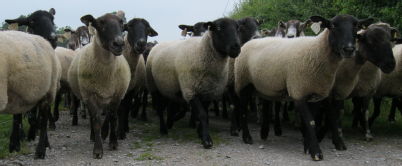Footrot

Footrot is an infectious bacterial disease of sheep causing pain and lesions on the feet, and can result in severe lameness. This has obvious implications for animal welfare, and impacts on farm productivity and sustainability, with estimates suggesting the disease accounts for annual losses of up to £84 million to the UK sheep industry alone.
The disease has a broad range of clinical presentations, varying from what appears to be a mild skin irritation of the feet [interdigital dermatitis] to a clinical case of footrot where the sole and / or wall of the hoof is underrun, exposing the sensitive tissue beneath. Dichelobacter nodosus is the causative bacterium and plays a key role in disease initiation; a second pathogen, Fusobacterium necrophorum, plays a secondary role in disease. Both of these species are anaerobic (meaning they prefer to grow in the absence of oxygen), and there is a complex interaction between the environment, host and pathogen that all influence whether and when a sheep becomes lame with footrot.
Recent work from Warwick has suggested that the environment plays a key role in disease transmission from birth; and that the load of bacteria on a sheep’s foot is key to the development and persistence of disease. D. nodosus levels are higher the week before a case of interdigital dermatitis or footrot, and F. necrophorum levels highest during a case of footrot. Current work in Warwick focuses on studying Dichelobacter nodosus and Fusobacterium necrophorum through field work, lab work and models combining epidemiology with environmental microbiology to investigate disease severity, persistence and dynamics.
More information about this infection, and current research activities can be found here.
Publications
2015
Mohd Muzafar, Leo A Calvo-Bado, Laura E Green, Edward M Smith, Claire L Russell, Rose Grogono-Thomas, Elizabeth MH Wellington (2015) 'The role of the environment in transmission of Dichelobacter nodosus between ewes and their lambs' Veterinary Microbiology (online) [Article]
Luci A Witcomb, Laura E Green, Leo A Calvo-Bado, Claire Russell, Edward Smith, Rose Grogono-Thomas, Elizabeth MH Wellington (2015) 'First study of pathogen load and localisation of ovine footrot using fluorescence in situ hybridisation (FISH)' Veterinary Microbiology 176 (3-4), 321 - 327 [Article]
Witcomb, Luci, Green, Laura E., Kaler, Jasmeet, Ul-Hassan, Atiya, Calvo-Bado, Leo A., Medley, Graham F., Grogono-Thomas, Rose and Wellington, Elizabeth M. H.. (2014) 'A longitudinal study of the role of Dichelobacter nodosus and Fusobacterium necrophorum load in initiation and severity of footrot in sheep', Preventive Veterinary Medicine, 115 (1-2), 48 - 55 [Article]
2014
Smith, Edward M., Green, Olivia, Calvo-Bado, Leo A., Witcomb, Luci, Grogono-Thomas, Rosemary, Russell, Claire L., Brown, J. C., Medley, Graham, Kilbride, A. L., Wellington, E. M. H., and Green, Laura E.. (2014) 'Dynamics and impact of footrot and climate on hoof horn length in 50 ewes from one farm over a period of 10 months.', Veterinary Journal, 201 (3), 295 - 301 [Article]
Russell, C.L., Smith, E.M., Calvo-Bado, L.A., Green, L.E., Wellington, E.M.H., Medley, G.F., Moore, L.J. and Grogono-Thomas, R. (2014). Multiple Locus VNTR Analysis highlights that geographical clustering and distribution of Dichelobacter nodosus, the causal agent of footrot in sheep, correlates with inter-country movements. Infection, Genetics and Evolution, 22; 273-279 [Article]
Funded by: DEFRA, BBSRC, NERC, AHDB Beef and Lamb, BVA AWF
WIDER people involved
Laura Green
Kevin Purdy
Matt Keeling
Jolene Atia
Emma Monaghan
Ed Smith
Holly O'Kane
Jess Gaudy
Kat Giebel
Rachel Clifton
Nicola Liu
Zoe Willis
External collaborators
Rose Grogono-Thomas (Bristol)
